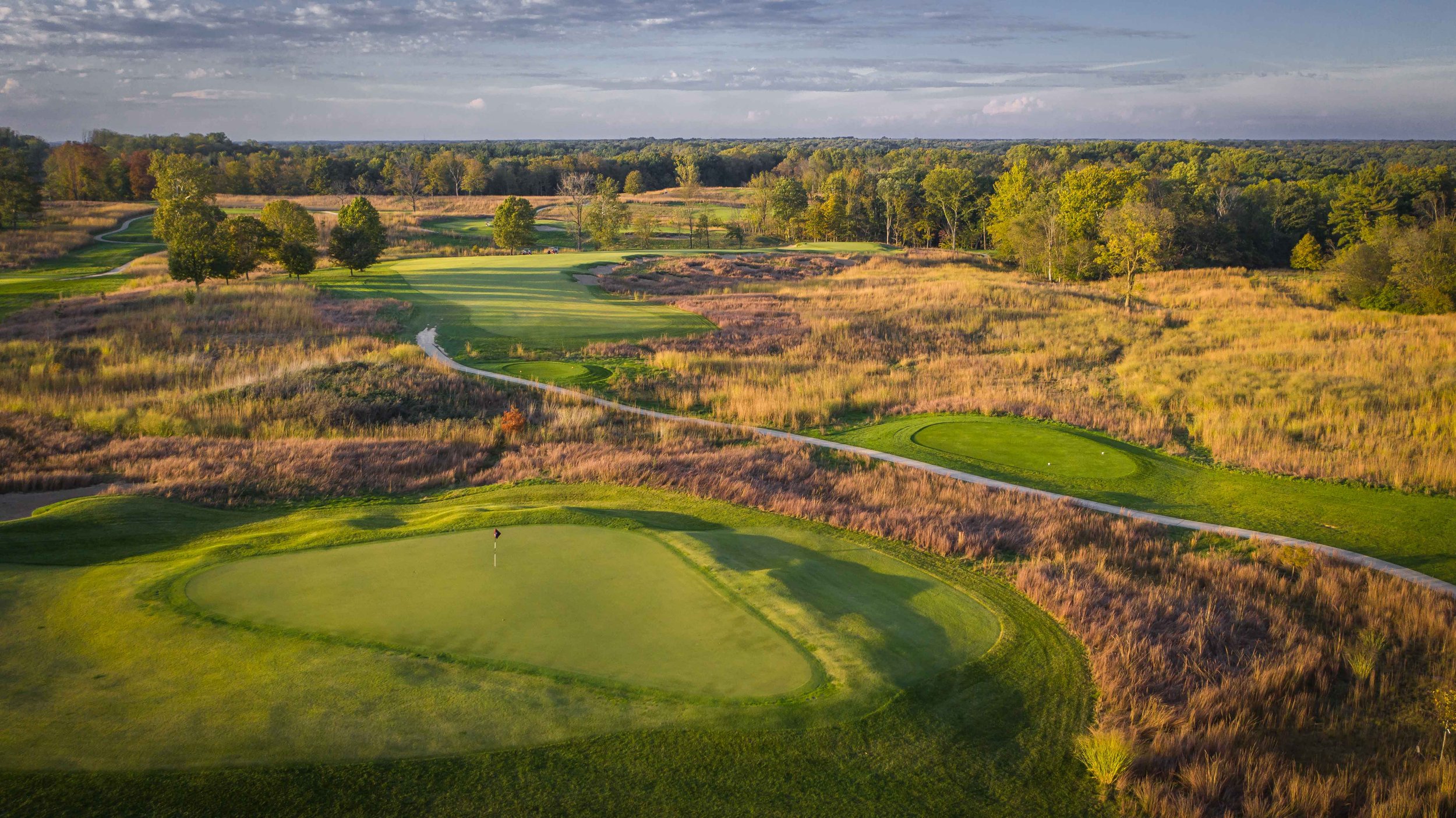A Buddies’ Road Trip: Compelling Courses by World-Renowned Architects Just South of the Border
By Jason Manshum
Editor’s note: This is the first of a two-part series on golf in Indiana. Check back in December for part II.
Pete Dye. Donald Ross. Bill Coore and Ben Crenshaw. Names that would arguably be on the Mount Rushmore of golf course architects. One might think you’d have to travel far to play their world-renowned courses; particularly those publicly accessible. If you think that, you’re wrong. All that Michigan golfers need to do is travel south of the border – to Indiana.
Me and nine friends recently embarked on our annual golf trip. While we’ve played Michigan’s great courses on every previous junket, this year we descended upon Hoosier country to play the Pfau Course at Indiana University, the Warren Course at Notre Dame, Sultan’s Run in Jasper, and the Donald Ross and Pete Dye courses at French Lick. In this first of a two-part series, we look at the two college courses first, which bookended our trip - we played Pfau on our way down and Warren on our way back.
Pfau Course at Indiana University
Our journey started in Bloomington. This course provided a great test of skill for our first day. Designed by Steve Smyers and two-time major winner and Hoosier native Fuzzy Zoeller, the Pfau Course opened in 2020, sitting on the same site as the previous IU course. The course, however, does not feel like it’s a couple years old. It blends in well with the natural landscape of forest and open spaces. In addition, the bunkers – 147 of them – were intentionally left rugged looking with overgrown edges. Minimalism may be an over-saturated term in golf these days, but Pfau felt minimalist in the best ways. It’s beautifully natural and not pretentious.
The Pfau Course has zoysia fairways. It was a bit jarring, yet interesting, to have the power cart rocking or swaying from side to side as we traversed the fairways due to the zoysia. This swaying action felt reminiscent to the swaying you often get on Michigan highways due to heavy truck traffic! Once our group got used to the how the grass played differently than home, particularly near and on the greens, we were ready to take in the natural beauty of the course while enjoying the test laid out before us.
There’s not an unmemorable hole, beginning with the opening tee shot. Pfau is very challenging, but I enjoyed the round due to the creativity needed to manage your way around each hole. A great example of this would be 14. Fourteen is a tasty little dogleg right. From the tee box, you must decide: make the hole shorter and take on the bunkers or play it safe? If you take on the bunkers (as I did), you’ll learn that the fairway slopes away from the tee. I was fortunate to run through the fairway only a few feet, leaving a getable wedge into the green. Even then, it’s a tricky two-putt if you’re on in regulation due to the back-to-front sloping green. Just for another layer of fun, the pin on this day was front.
While the Pfau Course could arguably be the most difficult of the courses we played, it’s playable for anyone. Six tee options range from 4,586 to 7,908 yards. This type of variety is paramount for a group that ranges from 40-somethings to 70-somethings and with handicaps of 9 to 30+. It’s a course I wanted to play again immediately after walking off 18 green. Pfau is also the third best course you can play in Indiana and seventh best college course in the country, according to GolfWeek.
The Warren Course at Notre Dame
Our trip concluded at the land of the Fighting Irish on the Coore-Crenshaw designed Warren Course at Notre Dame. I’m not Irish. But I’m Catholic, which I thought would surely come in handy for this Sunday afternoon round!
The Warren Course was a great change of pace from Southern Indiana to end our trip. It is more traditional to classic layouts in Michigan. It’s a bit links-esque yet nested on a wooded piece of property. The fairways were lush. The severe undulations of the prior day (Pete Dye Course at French Lick) were replaced with gently rolling terrain. Although we were on power carts, this is a great course to enjoy a walk – even if you’re not a collegiate athlete. And it's a stern enough test to have hosted the 2019 U.S. Senior Open.
Many holes are lined with fescue, heather and native grasses. This is appealing to the eye, and friendly to your ball as much of it is on the outer parameter of holes, giving you maximum playability. However, as I learned on the second hole, you won’t find your ball should you veer off-path and find yourself in the long stuff.
Coore and Crenshaw interlace 18 beautiful holes through this Audubon International certified wildlife habitat. One of my favorite holes is the signature 16th, which played as the opening hole for the 2019 U.S. Senior Open. While a driver is not needed off the tee, you must carry a creek to get in prime position for your approach. The left side is a no-no due to heavy bunkering. You may think you need to flirt with these bunkers on the tee to set up a good approach, but the elevated green is receptive to coming in from the right side. Just avoid the front pot bunker, as well as going long over the green – unless you like punishing yourself!
With Notre Dame Stadium nearby, and the golden dome visible in some spots, this course, rated as the fourth Best Course You Can Play in Indiana and tied for ninth as Best College Course in America by GolfWeek, is a great experience both on and off the course.
As noted, come back in December to learn about our experience at French Lick and Sultan’s Run.




